CS 563 Final Project
Damon Blanchette-- Theme --
For my final project, I plan to combine two things I love: computer graphics and quality craft beer. I'll be creating a render very similar to this (low-quality) image I took with my phone:

All brews that Allagash release are fantastic (the Allagash Tripel is a personal favorite), but this one, the Hugh Malone Ale, in particular, is a limited edition that stands out. I'll need to either scan that label somehow in high quality to get it in my render, or maybe I could just email the brewery and see if they will send me the image in large-format.
While this photo was taken in a kitchen environment, I plan on making the setting for the render a bar or pub. I know I've seen somewhere online a great panoramic image, that may have been HDRI, of the inside of a pub somewhere. I had thought it was originally a light probe image, but I couldn't find it on Paul Debevec's website. I will continue to search for it.
Some inspiration for this image is from Josh Wills' winning image in the 2003 UCSD Rendering Competition, which can be seen here: http://graphics.ucsd.edu/~jwills/renders/mm.html. His image is incredibly realistic, and it is something I hope to mirror in my render, though mine will hopefully be even better. My scene will differ in a few ways, including just the look of beer as opposed to whiskey, the beer "head" that will need to be included, and the surrounding scene.
I'll be using a few of the algorithms and effects from the class text (Ray Tracing from the Ground Up by Kevin Suffern) to create the render, including:
- Depth of Field.
- Texture Mapping.
- Some of the transparency code.
In order to create the render, there are multiple pieces of functionality I will need to add to our base ray tracer, including, but probably not limited to:
- Photon Mapping, for general realism and caustics.
- Environment Mapping, for realism.
- Beer's Law (aptly named) and Fresnel terms for realistic glass.
- Some kind of acceleration scheme (or I'll need to find a very fast computer).
- A way to do the "head" of the beer: millions of tiny bubbles.
I plan to update this page as I'm doing the project, as a sort of "work in progress" so you, the world, can follow my process.
-- Modeling --
This will undoubtedly be the easiest part of the entire project. I'm going to model the bottle and tulip glass from scratch in Blender and export them as .ply files for import into the ray tracer. The table on which the glass and bottle stand will either be just a simple plane or a table top also modeled in Blender.
Here are some screen captures of my work in Blender with modeling:
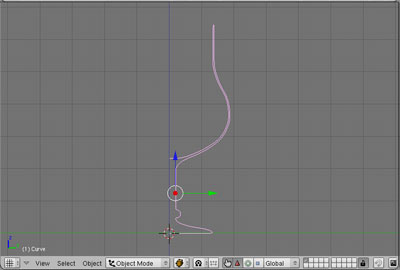
The above image is my bezier spline interpretation of the cross section of the tulip glass. When you take that and rotate it around 360 degrees, you get this:
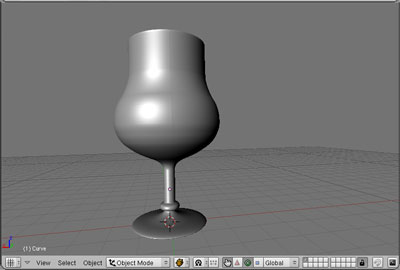
Below is a full screenshot of what the label looked like separated from the bottle. I took the bottle mesh and cut out just the faces I figured would make up the label, and then pasted the label onto them with UV mapping.
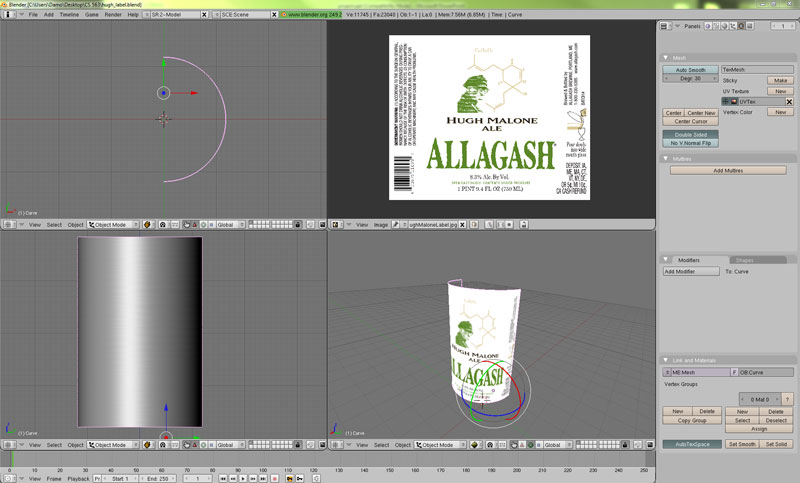
-- References --
In addition to Josh Wills' image, I will be using a variety of references:
- I found a paper by Paul Cleary et al about making the foam on top of various liquids, which should help me with the beer head. Here's the pdf: ACM link. The paper is about animating the bubbles, but hopefully I will be able to simplify it for a static image.
- This page on our professor's own WPI site has a great explanation of photon mapping.
- Global Illumination using Photon Maps by Henrik Wann Jensen - the original paper introducing Photon Maps from 1996.
- Wikipedia article on Photon Maps - http://en.wikipedia.org/wiki/Photon_mapping
- kd-trees, which are used to hold the data from the two Photon Mapping passes: http://en.wikipedia.org/wiki/Kd-tree
- I used this kd-tree library: http://code.google.com/p/kdtree/
- This google code ray tracer by the same author as the kd-tree library.
- Focus on Photon Mapping by John Marlon. Amazon
- Realistic Image Synthesis using Photon Mapping by Henrik Wann Jensen. Amazon
- Ray Tracing from the Ground Up by Kevin Suffern, the book we used for the class. Book Website
- This page by Zack Waters about photon mapping.
- This amazing page by Grant Schindler about photon mapping, complete with an in-browser live demo.
-- Architecture and Updates for the Base Ray Tracer --
Here's a very high level class diagram showing pretty much all the classes I'll be using, except for the utility classes (Ray, BBox, Vector3D) which I won't need to change anyway. Classes I'll be adding or changing from book's code are glowing orange. I'll probably need to highlight or add more classes as I go on and figure out how exactly I'm implementing certain features (especially photon mapping).
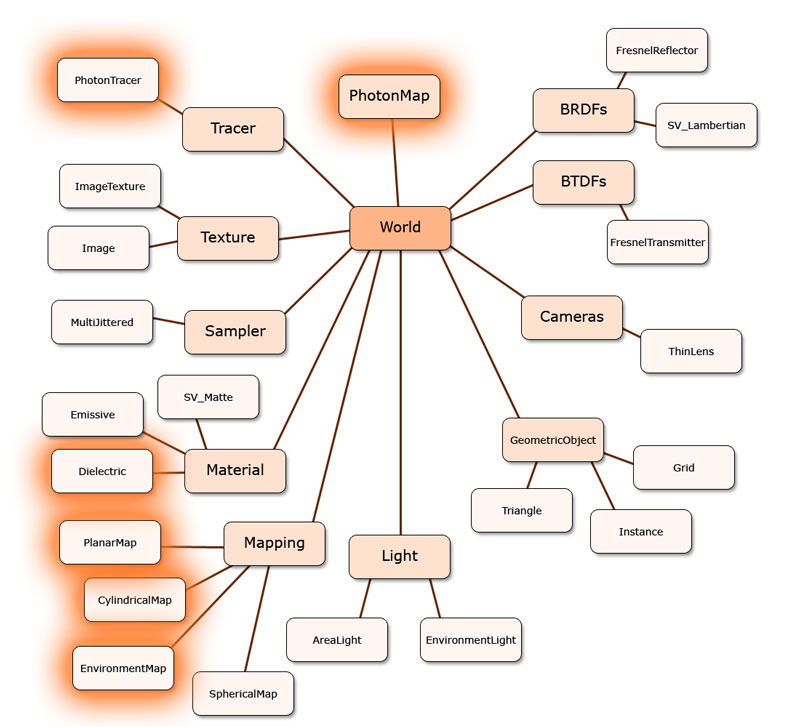
I'll need to basically create an entire class just for Photon Maps, which is listed at the top. This will also entail creating the pieces necessary for kd-trees, which will store the data, and a data structure for a Photon, which is what gets shot through the scene to make the maps.
I will most likely need to create a completely new Tracer (which I'll call PhotonTracer) to be able to utilize the photon maps created by the PhotonMap class.
The Dielectric material will need to be edited a bit to get the Beer's Law equations in there.
The extra Mapping classes are for textures - Planar for the table, Cylindrical for putting the label on the bottle, and Environment for an environment map.
*Update* After a few weeks of actual work on the project, I found that the classes I needed to change were different than I expected. Here is a more accurate image of the class changes:
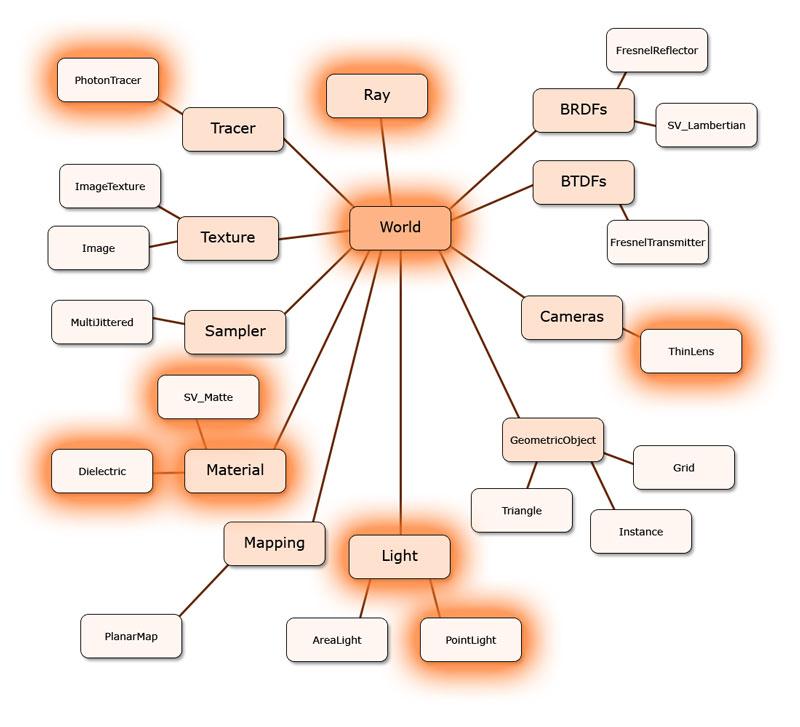
By far the biggest changes involved the World and PhotonTracer classes. The World class now contains the new code (quite a bit of it) for building both the global and caustics photon maps. It also contains the new Photon struct, which holds the photon's power, direction, and position. The PhotonTracer class is completely new, and has all the code for doing normal ray tracing and also reading through the photon maps for determining illumination.
The Ray class was changed to add variables pertaining to photons.
Small changes were made to the Light class (and subclasses), the Material class (and subclasses), and the ThinLens camera class. All changes involved adding functions so that they would work with photon mapping.
-- Performance --
Test renders were created fairly quickly, on the order of anywhere between 2 to 30 minutes. Render times were obviously very much affected by multiple variables, including: number of samples per pixel, number of photons fired into the scene, maximum depth of the rays and photons, size of the final image, and number of photons gathered for pixel light contribution. Increasing the values of any of these variables created render times in the hours.
-- Concerns --
There are a few concerns about doing the project as I've conceived it in my head:
- Photon mapping will require some rather large changes to quite a few parts of the base ray tracer. This is my single largest concern. I don't know exactly how big or what changes will need to be made (yet), but I'm thinking it will not be all that straightforward.
- Beer's law, Fresnel terms, and advanced transparency. I don't exactly know yet how difficult it is to add these advanced transparency effects to the ray tracer.
- Will this take a week to render?
- The head of the beer is a big question mark. If it turns out to be too much to create actual super-realistic foam bubbles, I may just fudge it with a lot of tiny semitransparent spheres or even a texture if all else fails (or I run out of time).
-- Timeline --
- Week 1: Modeling, set up scene and camera, start on photon mapping.
- Week 2: Continue photon mapping, start advanced transparency (Beer's Law, Fresnel)
- Week 3: Finish up advanced transparency, work on beer head, tweak settings for realism.
- Week 4: Test, tweak, and render.
-- Updates --
- Beginning of Semester to 3/29/10:
Two parts of the ray tracer that I'll need are fairly well complete - texture mapping and fresnel terms for the glass. Here are a few images rendered as tests...
This is some clear glass, with fresnel reflections and transmission, which will work well for the tulip glass holding the beer:
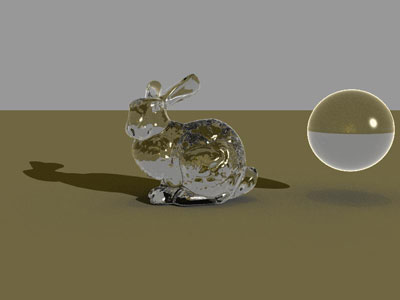
Here is the same image, but with brown colored glass, which (when made a bit lighter) will work great for the bottle next to the glass:
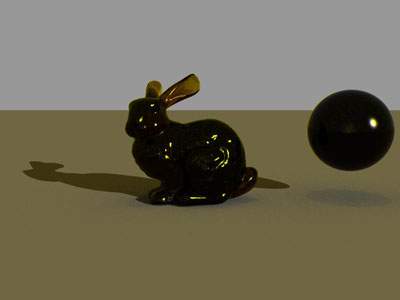
And, here's my first shot at an actual cup-shaped object made out of the same glass material as the bunnies. It's obvious I need a better mesh! The top of that glass is totally messed up.
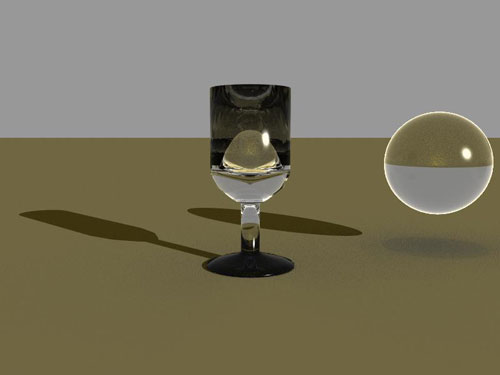
Allagash came through! What an awesome brewery. Here's one of three images they sent me, and this one is absolutely perfect for what I need:
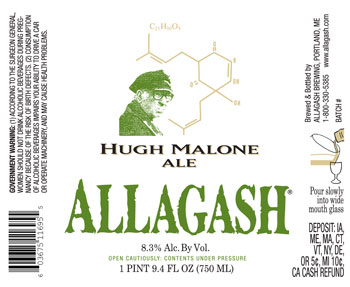
- 3/30/10:
I worked a while in Blender and created a fairly good model of the tulip glass, which I brought into the ray tracer and rendered with a clear glass dielectric material. Looks pretty good for a first try if I do say so myself!
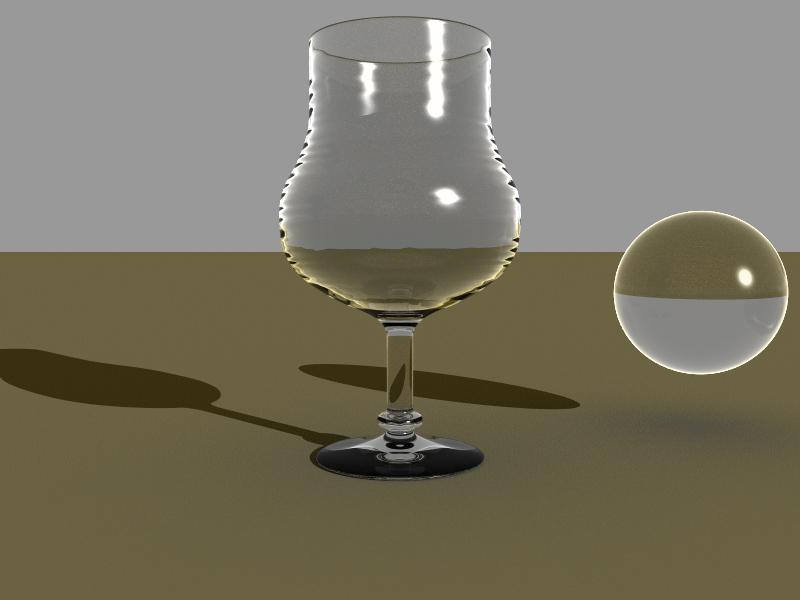
The model itself needs work - all those wavy lines at the edges and the wavy specular highlights are almost certainly due to the way the triangles are arranged. I'm going to try increasing the number of triangles and that should smooth things out a bit.
Another thing - this image with 25 samples per pixel took 32 minutes to render! That's just one glass, with no global illumination. I'm really going to need to figure out some kind of acceleration scheme, or get a faster computer!
- 3/31/10:
I very much increased the number of triangles in the mesh (to about 230,000) and ended up with a still not perfect but much better image:
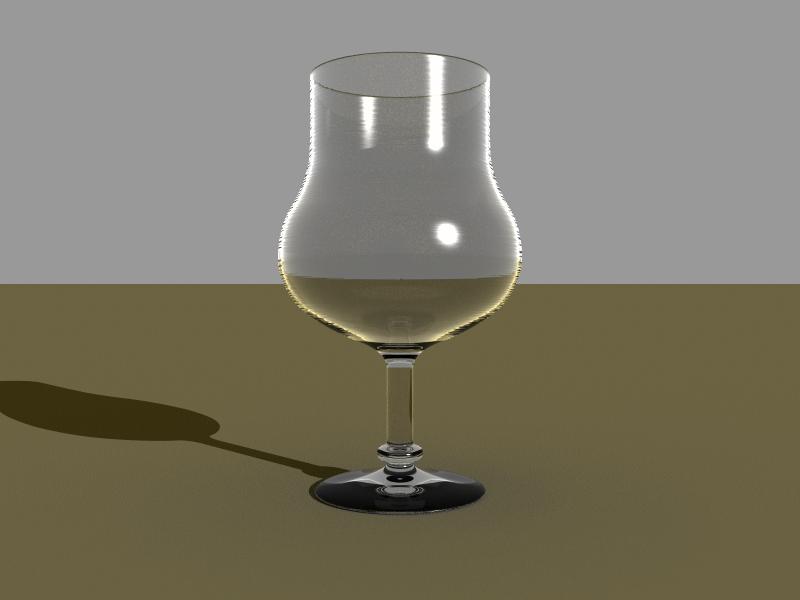
Looks like I'll still need more - the edges and the specular highlights are still noticeably wavy.
- 4/4/10:
Got the Allagash bottle pretty much done, along with the label (which is put on a half-cylinder shape with UV coordinates), and a wooden table:
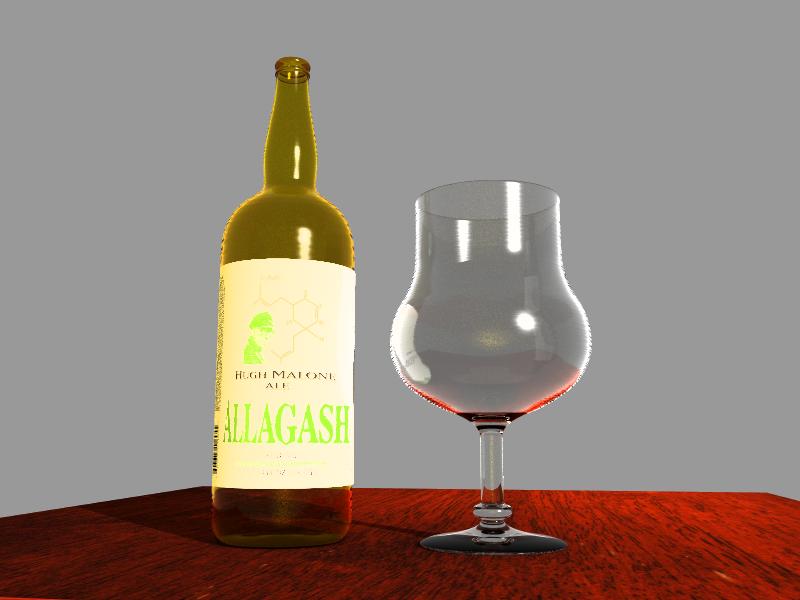
- 5/4/10:
In the last month much has happened. Photon mapping took BY FAR the most amount of time for me to get working – as I'd say about 95% of my time was spent on it (hours every night for the entire month). I went through many, many iterations and trials attempting to get good looking images with photon mapping. Here are just a few of the test cornell box images I ended up with in the process:
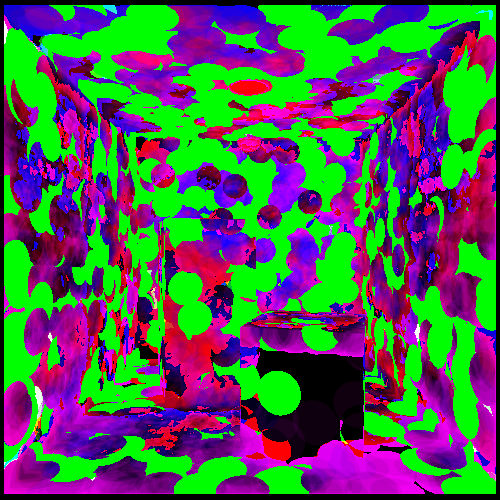
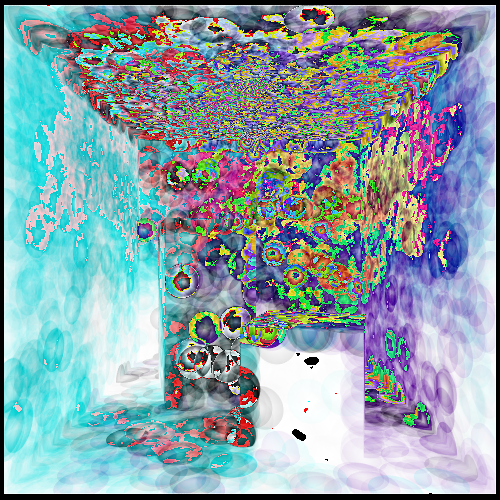
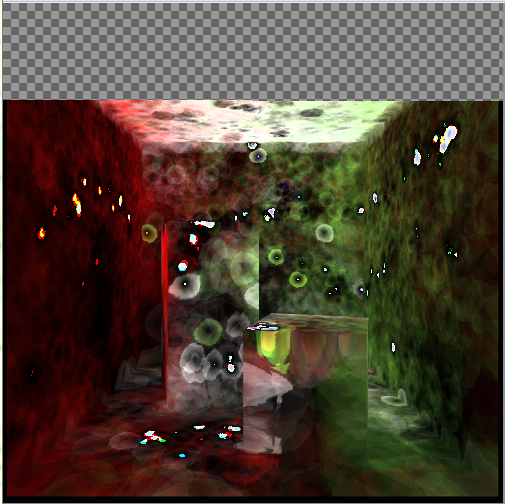
Here's photon mapping working (for the most part):

Somewhere around this point I got sick of cornell boxes and decided to work on the final image, using photon mapping:




The last one here is the most recent image I've come up with, rendered today, May 4th, 2010. The caustics are (basically) working, sort of. The beer looks ok. The glass is a bit bright, on both the bottle and the tulip glass. The bubbles, which consist of 30,000 tiny matte spheres, are certainly lacking. I plan on rendering a higher quality image, probably overnight tonight, since it will take a long time. This image only has 10 samples per pixel and gathers only a minimum of 20 photons per pixel. The background is gone because it completely messes up the other textures (see image above this one).
This project was severely hindered by problems with photon mapping. I put the blame on my own lack of programming experience, lack of sufficient time, and it is also my opinion that the ray tracer we were using was ill-suited for the addition of photon mapping.